Abstract
Lidocaine depresses automaticity in cardiac Purkinje fibers by decreasing the slope of slow diastolic depolarization, but the mechanisms of this effect are poorly understood. To test the proposal that the antiautomatic effect of lidocaine might be mediated by an increase in membrane potassium conductance, transmembrane voltage (Vm) was measured in Purkinje fibers perfused with sodium-deficient Tyrode containing choline as the major cation. Vm was varied by altering the external potassium concentration, [K]o, from 0.5 to 150 mM before and after lidocaine, 2.14 × 10-5 M, a concentration considered equivalent to clinical plasma antiarrhythmic levels. In Purkinje fibers, resting Vm varies linearly with [K]o plotted on a logarithmic scale from 4 to 150 mM, approximately as predicted by the Nernst equation. At [K]o of 0.5-2.7 mM, resting Vm diverges from the predicted potassium equilibrium potential (VK) resulting in an increased driving force for the outward K+ current (Vm — VK). In choline Tyrode at [K]o of 2.7 mM or less, lidocaine caused a significant increase in Vm, the change being a positive linear function of (Vm — VK) with a P < 0.01. This effect was more striking in Purkinje fibers with a Vm reduced by stretch. These findings imply that lidocaine increased membrane chord conductance for the potassium ion (gK).
Current-voltage relationships using intracellular current pulses were performed in choline Tyrode at [K]o of 0.5, 2.0, and 4.0 mM and, at each [K]o, lidocaine was found to increase membrane slope conductance (GK). The increase in GK was even more apparent when the current-voltage relationships in long Purkinje fibers was corrected for cable complications or when experiments were done in short Purkinje fibers. To minimize complications due to membrane rectifier properties, GK was measured using intracellular application of small hyperpolarizing current pulses as Vm was decreased from -90 to -60 mv by increasing the [K]o from 3 to 15 mM before and after lidocaine. Lidocaine increased the GK over this range of Vm.
These results suggest that lidocaine increases membrane potassium conductance within the range of Vm where the pacemaker potential is seen, an action which can account for its ability to suppress automaticity, and, in part, for its ability to prevent reentrant arrhythmias.
Full text
PDF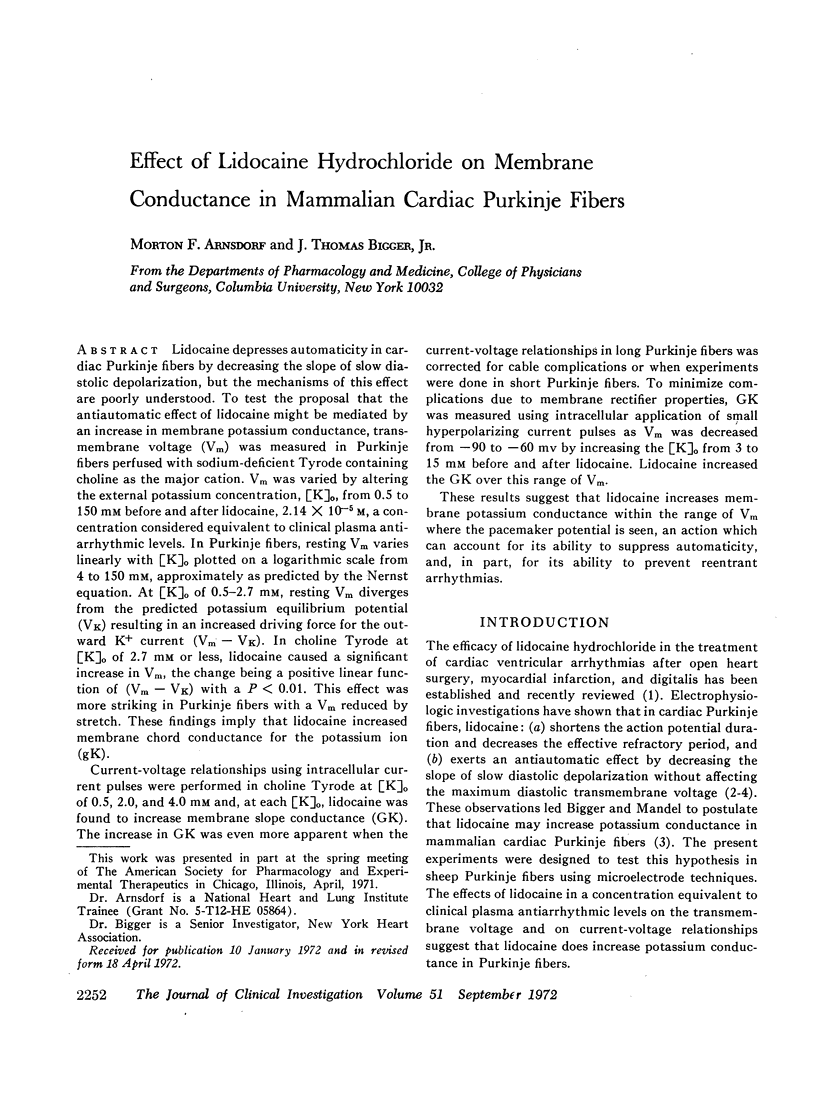
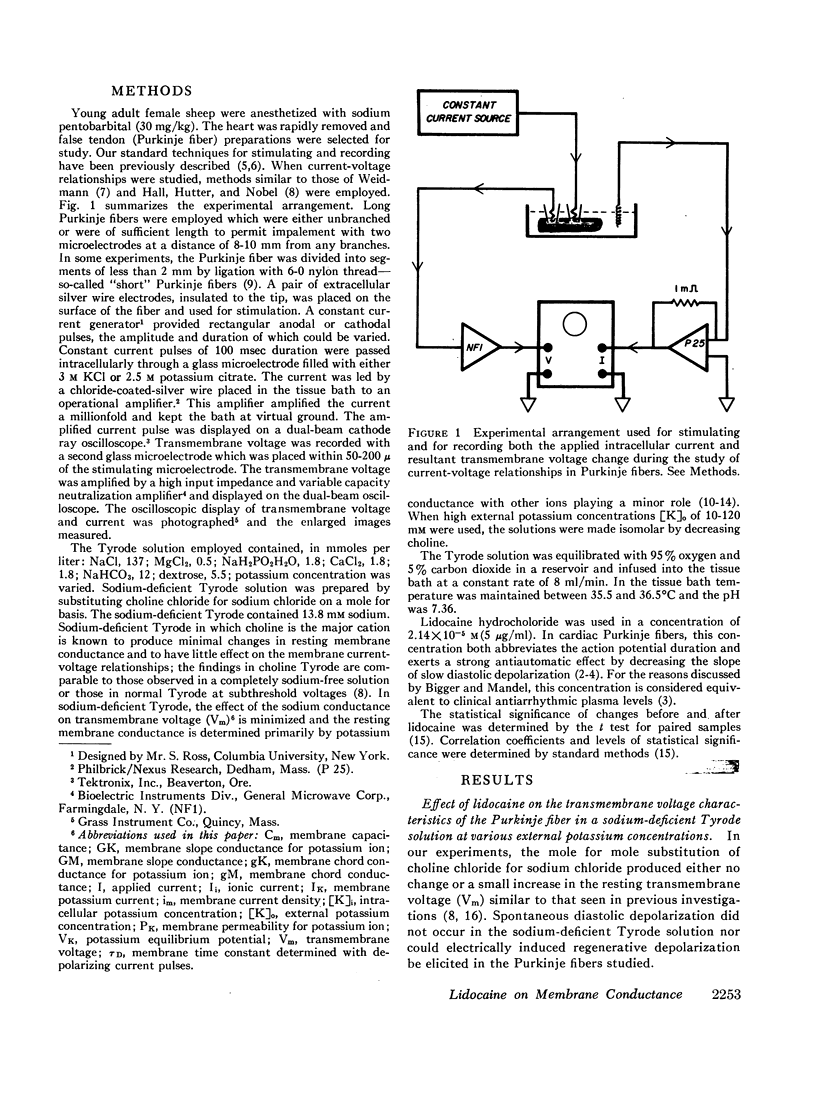
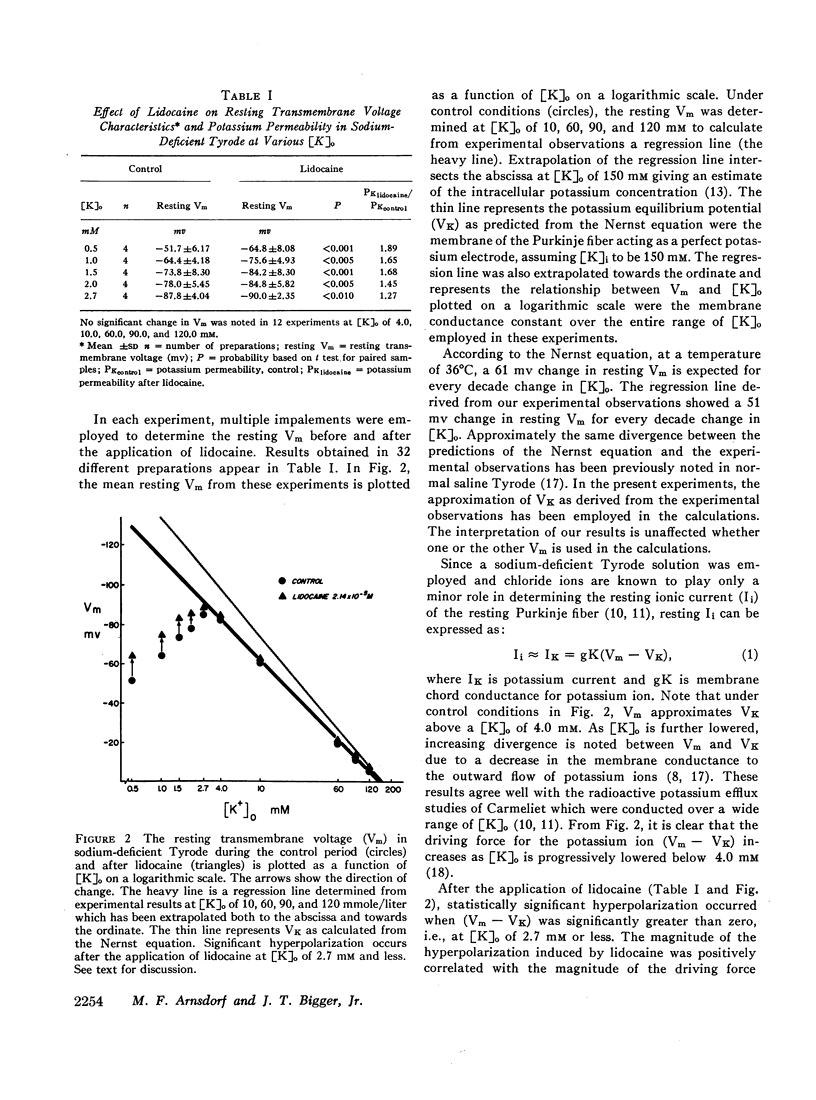

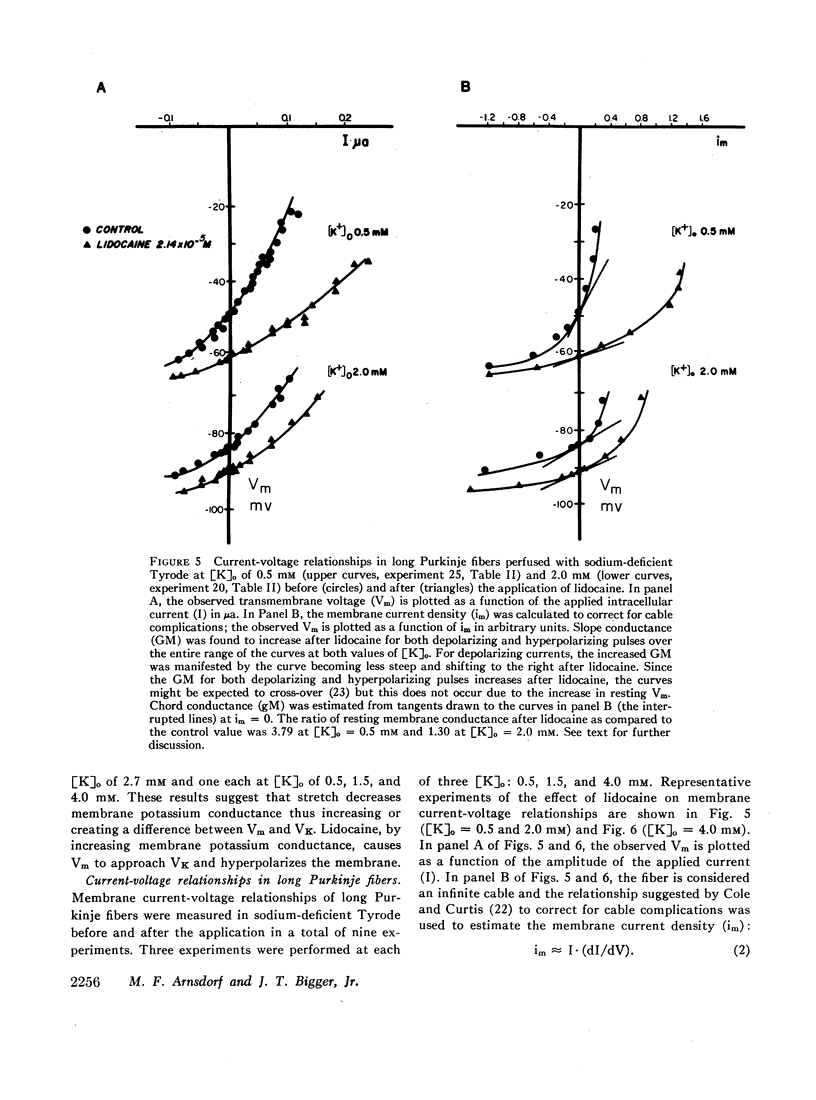
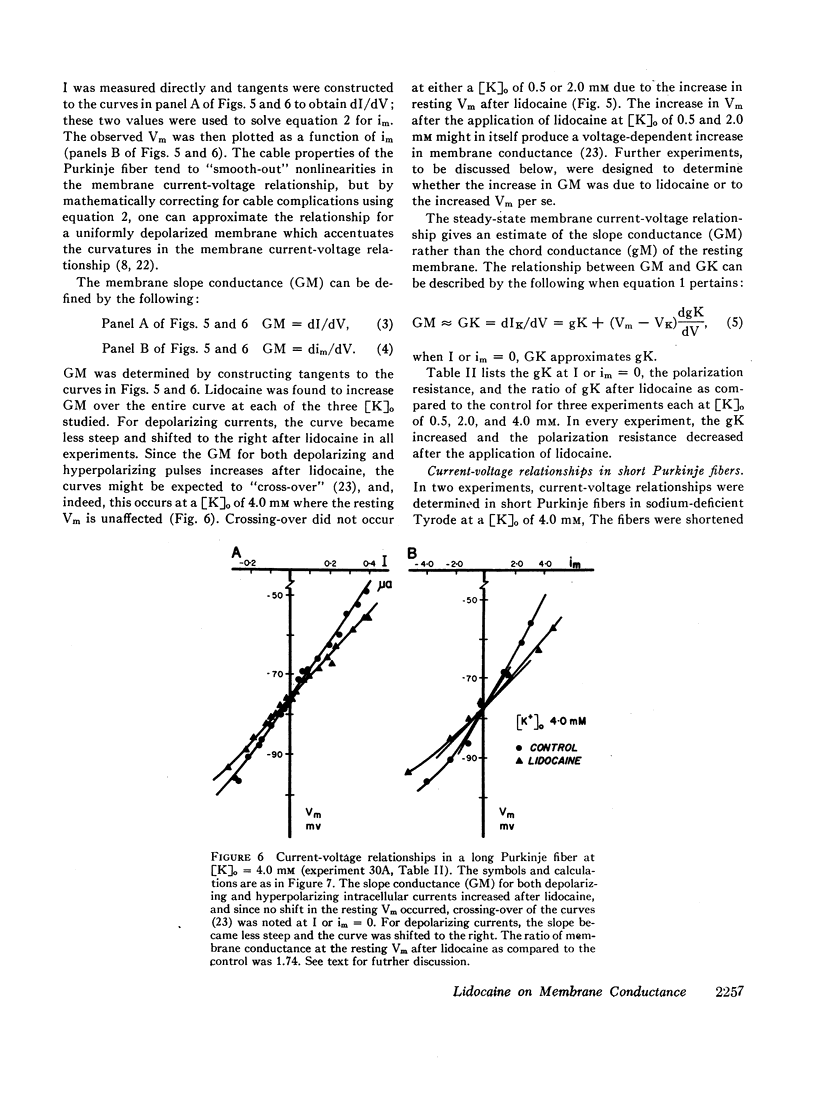
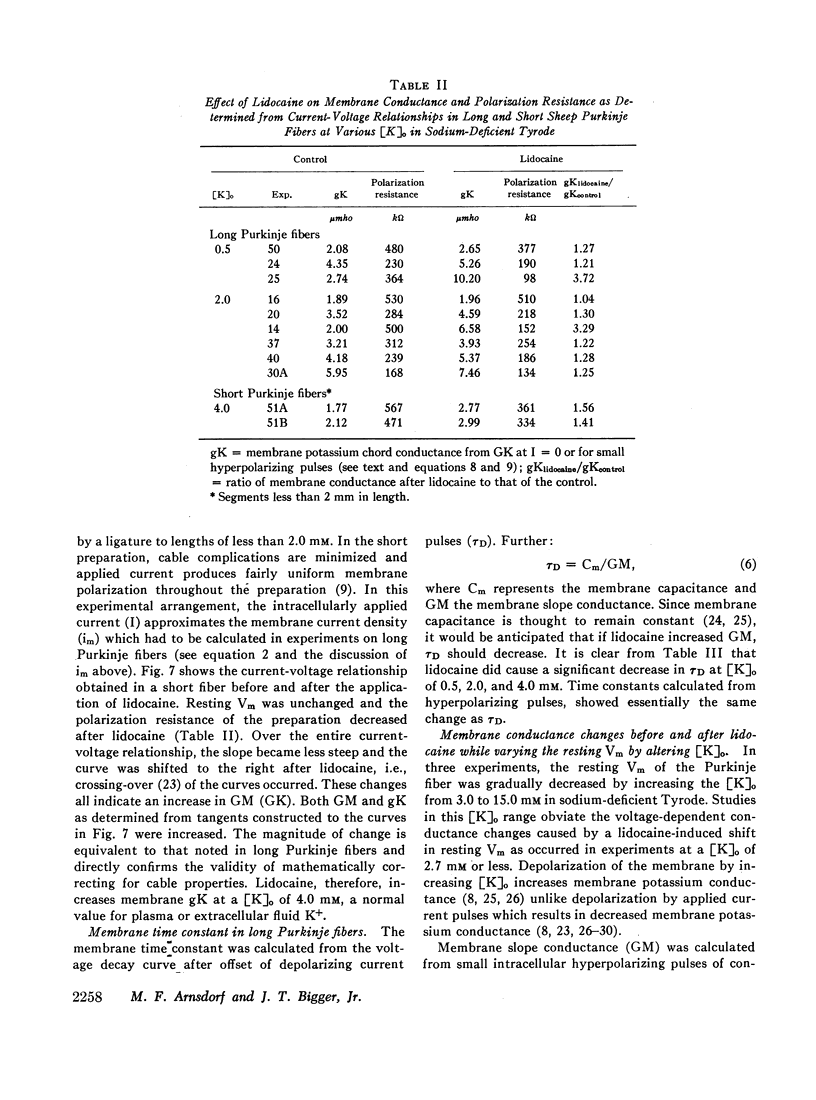
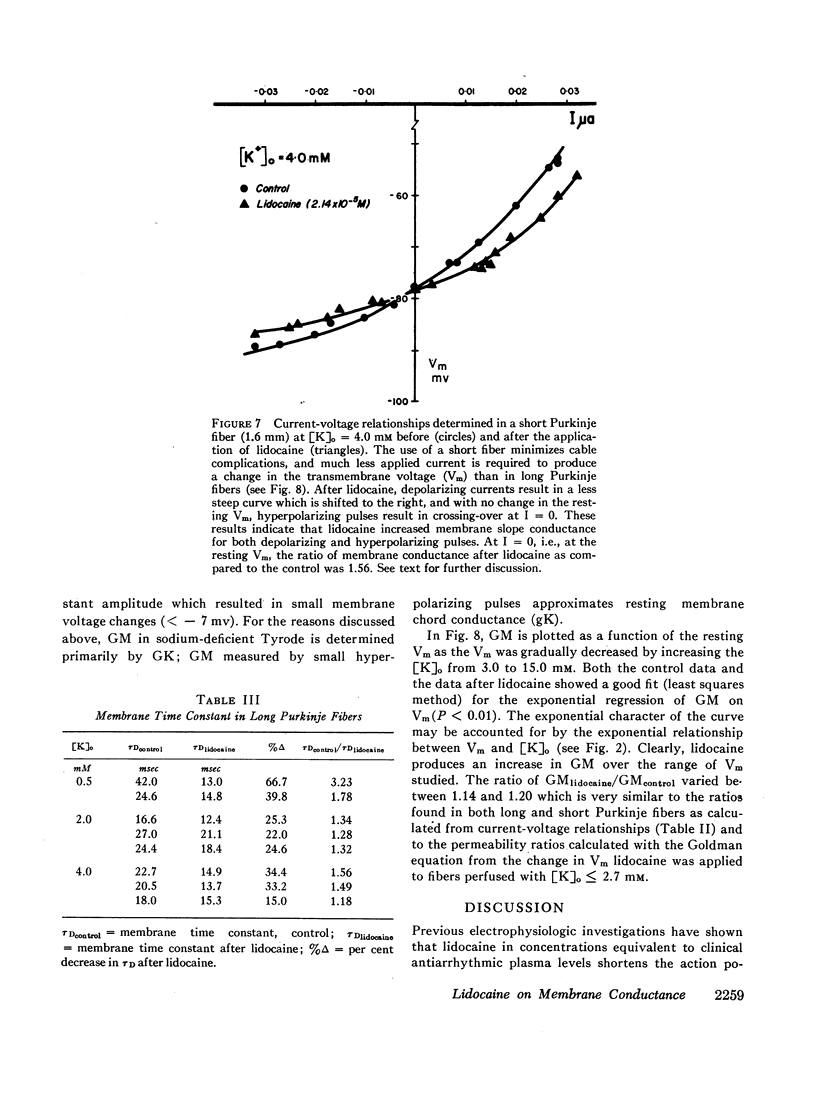
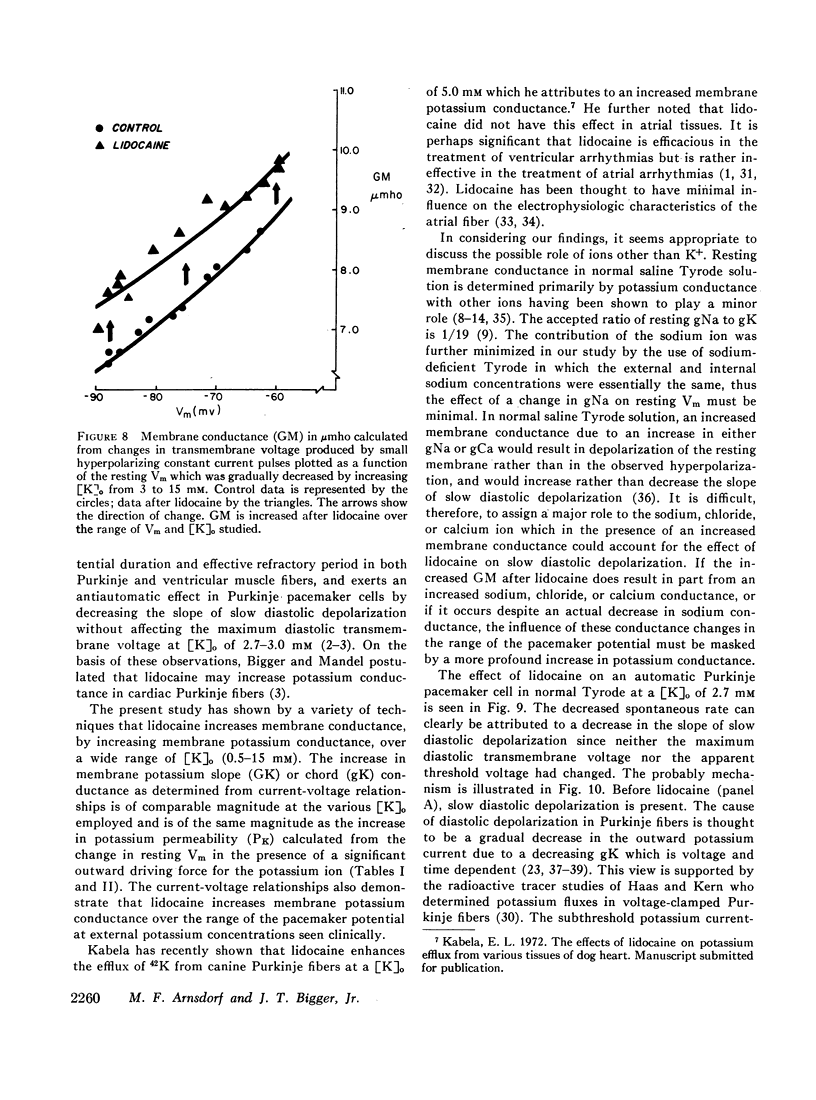
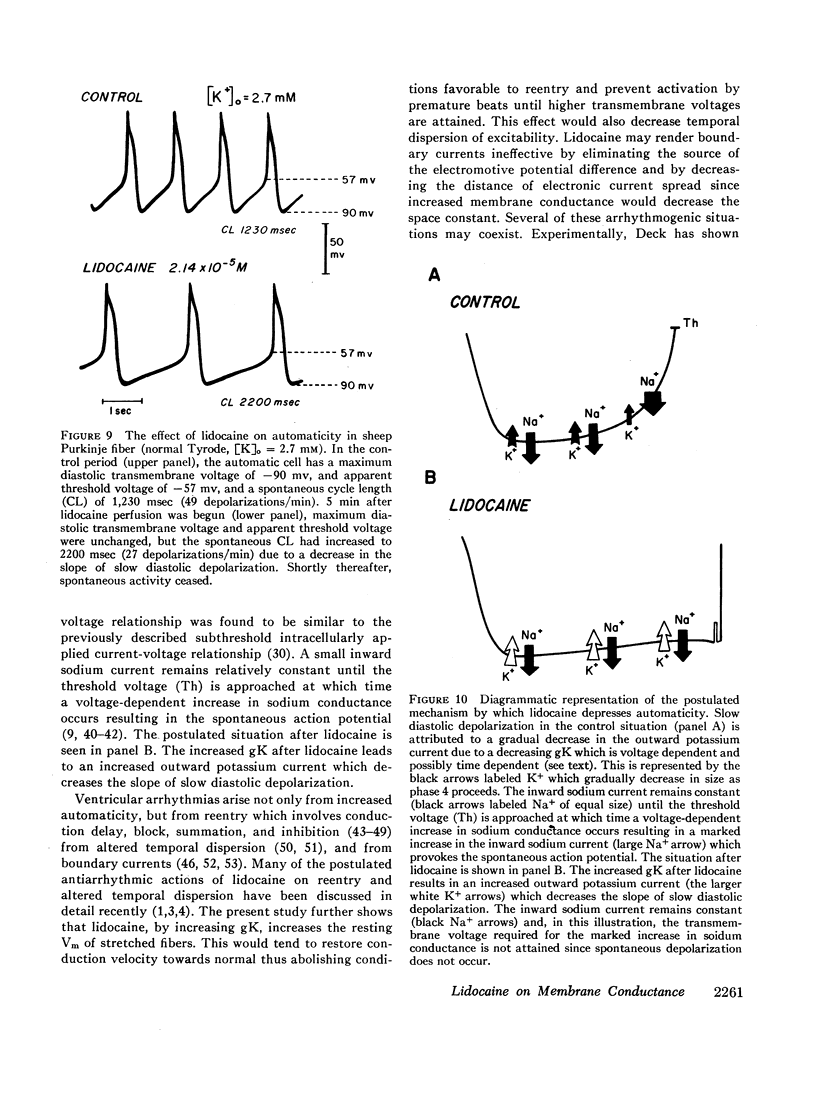
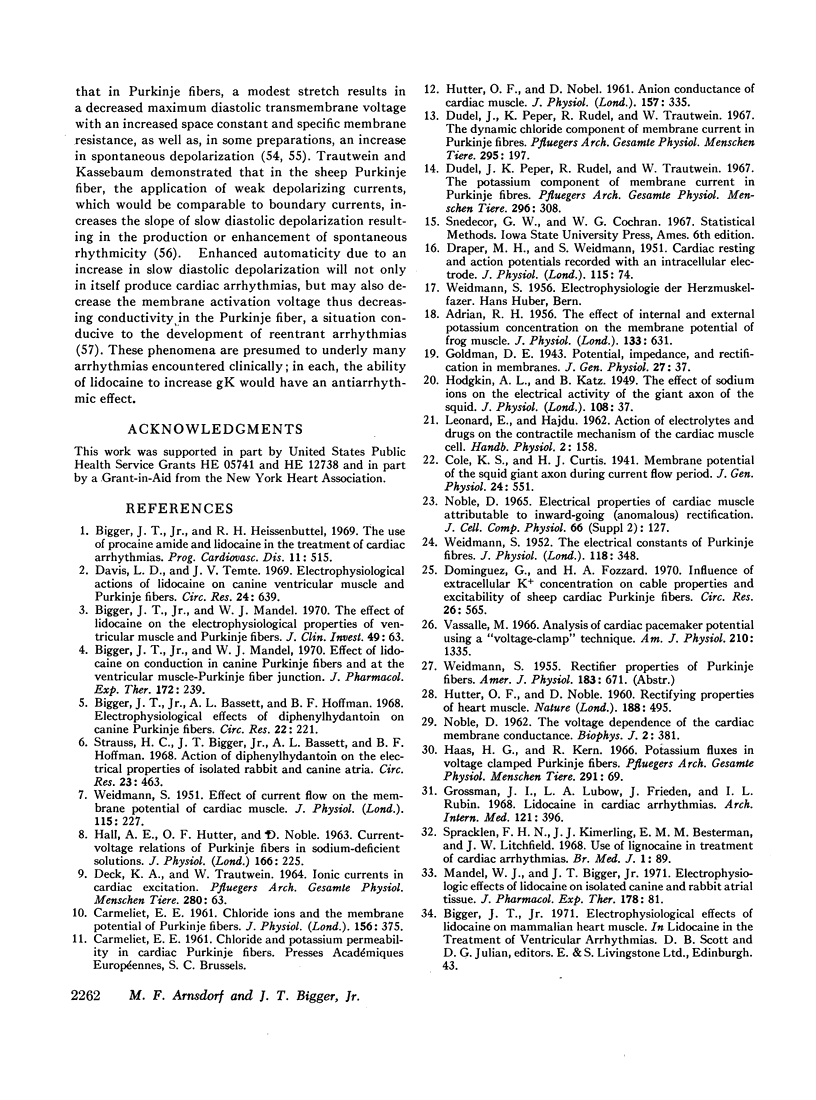
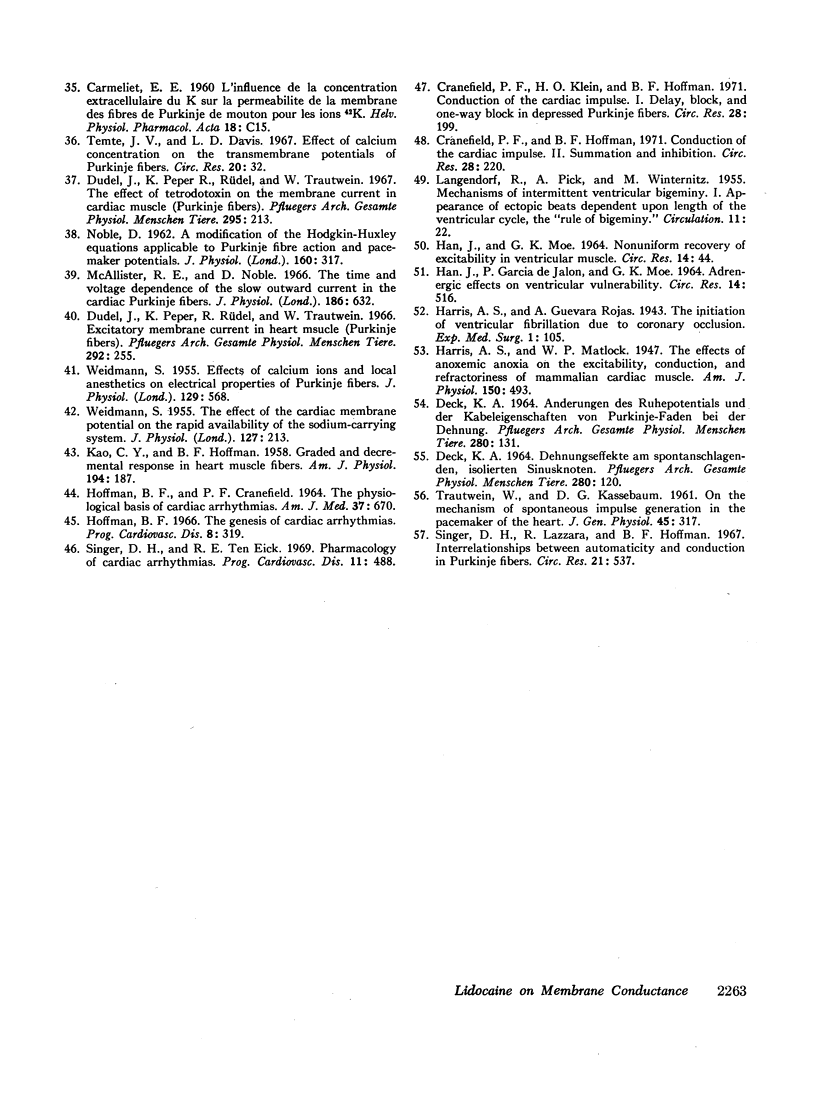
Selected References
These references are in PubMed. This may not be the complete list of references from this article.
- ADRIAN R. H. The effect of internal and external potassium concentration on the membrane potential of frog muscle. J Physiol. 1956 Sep 27;133(3):631–658. doi: 10.1113/jphysiol.1956.sp005615. [DOI] [PMC free article] [PubMed] [Google Scholar]
- Bigger J. T., Jr, Bassett A. L., Hoffman B. F. Electrophysiological effects of diphenylhydantoin on canine purkinje fibers. Circ Res. 1968 Feb;22(2):221–236. doi: 10.1161/01.res.22.2.221. [DOI] [PubMed] [Google Scholar]
- Bigger J. T., Jr, Heissenbuttel R. H. The use of procaine amide and lidocaine in the treatment of cardiac arrhythmias. Prog Cardiovasc Dis. 1969 May;11(6):515–534. doi: 10.1016/0033-0620(69)90004-8. [DOI] [PubMed] [Google Scholar]
- Bigger J. T., Jr, Mandel W. J. Effect of lidocaine on conduction in canine Purkinje fibers and at the ventricular muscle-Purkinje fiber junction. J Pharmacol Exp Ther. 1970 Apr;172(2):239–254. [PubMed] [Google Scholar]
- Bigger J. T., Jr, Mandel W. J. Effect of lidocaine on the electrophysiological properties of ventricular muscle and purkinje fibers. J Clin Invest. 1970 Jan;49(1):63–77. doi: 10.1172/JCI106224. [DOI] [PMC free article] [PubMed] [Google Scholar]
- CARMELIET E. E. Chloride ions and the membrane potential of Purkinje fibres. J Physiol. 1961 Apr;156:375–388. doi: 10.1113/jphysiol.1961.sp006682. [DOI] [PMC free article] [PubMed] [Google Scholar]
- Cranefield P. F., Hoffman B. F. Conduction of the cardiac impulse. II. Summation and inhibition. Circ Res. 1971 Feb;28(2):220–233. doi: 10.1161/01.res.28.2.220. [DOI] [PubMed] [Google Scholar]
- Cranefield P. F., Klein H. O., Hoffman B. F. Conduction of the cardiac impulse. 1. Delay, block, and one-way block in depressed Purkinje fibers. Circ Res. 1971 Feb;28(2):199–219. doi: 10.1161/01.res.28.2.199. [DOI] [PubMed] [Google Scholar]
- DECK K. A. ANDERUNGEN DES RUHEPOTENTIALS UND DER KABELEIGENSCHAFTEN VON PURKINJE-FAEDEN BEI DER DEHNUNG. Pflugers Arch Gesamte Physiol Menschen Tiere. 1964 Jul 1;280:131–140. [PubMed] [Google Scholar]
- DECK K. A. DEHNUNGSEFFEKTE AM SPONTANSCHLAGENDEN, ISOLIERTEN SINUSKNOTEN. Pflugers Arch Gesamte Physiol Menschen Tiere. 1964 Jul 1;280:120–130. [PubMed] [Google Scholar]
- DECK K. A., TRAUTWEIN W. IONIC CURRENTS IN CARDIAC EXCITATION. Pflugers Arch Gesamte Physiol Menschen Tiere. 1964 Jun 9;280:63–80. doi: 10.1007/BF00412616. [DOI] [PubMed] [Google Scholar]
- Davis L. D., Temte J. V. Electrophysiological actions of lidocaine on canine ventricular muscle and Purkinje fibers. Circ Res. 1969 May;24(5):639–655. doi: 10.1161/01.res.24.5.639. [DOI] [PubMed] [Google Scholar]
- Dominguez G., Fozzard H. A. Influence of extracellular K+ concentration on cable properties and excitability of sheep cardiac Purkinje fibers. Circ Res. 1970 May;26(5):565–574. doi: 10.1161/01.res.26.5.565. [DOI] [PubMed] [Google Scholar]
- Dudel J., Peper K., Rüdel R., Trautwein W. Excitatory membrane current in heart muscle (Purkinje fibers). Pflugers Arch Gesamte Physiol Menschen Tiere. 1966;292(3):255–273. doi: 10.1007/BF00362740. [DOI] [PubMed] [Google Scholar]
- Dudel J., Peper K., Rüdel R., Trautwein W. The dynamic chloride component of membrane current in Purkinje fibers. Pflugers Arch Gesamte Physiol Menschen Tiere. 1967;295(3):197–212. doi: 10.1007/BF01844100. [DOI] [PubMed] [Google Scholar]
- Dudel J., Peper K., Rüdel R., Trautwein W. The effect of tetrodotoxin on the membrane current in cardiac muscle (Purkinje fibers). Pflugers Arch Gesamte Physiol Menschen Tiere. 1967;295(3):213–226. doi: 10.1007/BF01844101. [DOI] [PubMed] [Google Scholar]
- Dudel J., Peper K., Rüdel R., Trautwein W. The potassium component of membrane current in Purkinje fibers. Pflugers Arch Gesamte Physiol Menschen Tiere. 1967;296(4):308–327. doi: 10.1007/BF00362531. [DOI] [PubMed] [Google Scholar]
- Grossman J. I., Lubow L. A., Frieden J., Rubin I. L. Lidocaine in cardiac arrhythmias. Arch Intern Med. 1968 May;121(5):396–401. [PubMed] [Google Scholar]
- HALL A. E., HUTTER O. F., NOBLE D. Current-voltage relations of Purkinje fibres in sodium-deficient solutions. J Physiol. 1963 Apr;166:225–240. doi: 10.1113/jphysiol.1963.sp007102. [DOI] [PMC free article] [PubMed] [Google Scholar]
- HAN J., GARCIADEJALON P., MOE G. K. ADRENERGIC EFFECTS ON VENTRICULAR VULNERABILITY. Circ Res. 1964 Jun;14:516–524. doi: 10.1161/01.res.14.6.516. [DOI] [PubMed] [Google Scholar]
- HAN J., MOE G. K. NONUNIFORM RECOVERY OF EXCITABILITY IN VENTRICULAR MUSCLE. Circ Res. 1964 Jan;14:44–60. doi: 10.1161/01.res.14.1.44. [DOI] [PubMed] [Google Scholar]
- HOFFMAN B. F., CRANEFIELD P. F. THE PHYSIOLOGICAL BASIS OF CARDIAC ARRHYTHMIAS. Am J Med. 1964 Nov;37:670–684. doi: 10.1016/0002-9343(64)90017-8. [DOI] [PubMed] [Google Scholar]
- HUTTER O. F., NOBLE D. Anion conductance of cardiac muscle. J Physiol. 1961 Jul;157:335–350. doi: 10.1113/jphysiol.1961.sp006726. [DOI] [PMC free article] [PubMed] [Google Scholar]
- HUTTER O. F., NOBLE D. Rectifying properties of heart muscle. Nature. 1960 Nov 5;188:495–495. doi: 10.1038/188495a0. [DOI] [PubMed] [Google Scholar]
- Haas H. G., Kern R. Potassium fluxes in voltage clamped Purkinje fibres. Pflugers Arch Gesamte Physiol Menschen Tiere. 1966;291(1):69–84. doi: 10.1007/BF00362653. [DOI] [PubMed] [Google Scholar]
- Hoffman B. F. The genesis of cardiac arrhythmias. Prog Cardiovasc Dis. 1966 Jan;8(4):319–329. doi: 10.1016/s0033-0620(66)80009-9. [DOI] [PubMed] [Google Scholar]
- KAO C. Y., HOFFMAN B. F. Graded and decremental response in heart muscle fibers. Am J Physiol. 1958 Jul;194(1):187–196. doi: 10.1152/ajplegacy.1958.194.1.187. [DOI] [PubMed] [Google Scholar]
- Mandel W. J., Bigger J. T., Jr Electrophysiologic effects of lidocaine on isolated canine and rabbit atrial tissue. J Pharmacol Exp Ther. 1971 Jul;178(1):81–93. [PubMed] [Google Scholar]
- McAllister R. E., Noble D. The time and voltage dependence of the slow outward current in cardiac Purkinje fibres. J Physiol. 1966 Oct;186(3):632–662. doi: 10.1113/jphysiol.1966.sp008060. [DOI] [PMC free article] [PubMed] [Google Scholar]
- NOBLE D. A modification of the Hodgkin--Huxley equations applicable to Purkinje fibre action and pace-maker potentials. J Physiol. 1962 Feb;160:317–352. doi: 10.1113/jphysiol.1962.sp006849. [DOI] [PMC free article] [PubMed] [Google Scholar]
- NOBLE D. The voltage dependence of the cardiac membrane conductance. Biophys J. 1962 Sep;2:381–393. doi: 10.1016/s0006-3495(62)86862-3. [DOI] [PMC free article] [PubMed] [Google Scholar]
- Singer D. H., Lazzara R., Hoffman B. F. Interrelationship between automaticity and conduction in Purkinje fibers. Circ Res. 1967 Oct;21(4):537–558. doi: 10.1161/01.res.21.4.537. [DOI] [PubMed] [Google Scholar]
- Singer D. H., Ten Eick R. E. Pharmacology of cardiac arrhythmias. Prog Cardiovasc Dis. 1969 May;11(6):488–514. doi: 10.1016/0033-0620(69)90003-6. [DOI] [PubMed] [Google Scholar]
- Spracklen F. H., Kimerling J. J., Besterman E. M., Litchfield J. W. Use of lignocaine in treatment of cardiac arrhythmias. Br Med J. 1968 Jan 13;1(5584):89–91. doi: 10.1136/bmj.1.5584.89. [DOI] [PMC free article] [PubMed] [Google Scholar]
- Strauss H. C., Bigger J. T., Jr, Bassett A. L., Hoffman B. F. Actions of diphenylhydatoin on the electrical properties of isolated rabbit and canine atria. Circ Res. 1968 Sep;23(3):463–477. doi: 10.1161/01.res.23.3.463. [DOI] [PubMed] [Google Scholar]
- TRAUTWEIN W., KASSEBAUM D. G. On the mechanism of spontaneous impulse generation in the pacemaker of the heart. J Gen Physiol. 1961 Nov;45:317–330. doi: 10.1085/jgp.45.2.317. [DOI] [PMC free article] [PubMed] [Google Scholar]
- Temte J. V., Davis L. D. Effect of calcium concentration on the transmembrane potentials of Purkinje fibers. Circ Res. 1967 Jan;20(1):32–44. doi: 10.1161/01.res.20.1.32. [DOI] [PubMed] [Google Scholar]
- Vassalle M. Analysis of cardiac pacemaker potential using a "voltage clamp" technique. Am J Physiol. 1966 Jun;210(6):1335–1341. doi: 10.1152/ajplegacy.1966.210.6.1335. [DOI] [PubMed] [Google Scholar]
- WEIDMANN S. Effect of current flow on the membrane potential of cardiac muscle. J Physiol. 1951 Oct 29;115(2):227–236. doi: 10.1113/jphysiol.1951.sp004667. [DOI] [PMC free article] [PubMed] [Google Scholar]
- WEIDMANN S. Effects of calcium ions and local anesthetics on electrical properties of Purkinje fibres. J Physiol. 1955 Sep 28;129(3):568–582. doi: 10.1113/jphysiol.1955.sp005379. [DOI] [PMC free article] [PubMed] [Google Scholar]
- WEIDMANN S. The effect of the cardiac membrane potential on the rapid availability of the sodium-carrying system. J Physiol. 1955 Jan 28;127(1):213–224. doi: 10.1113/jphysiol.1955.sp005250. [DOI] [PMC free article] [PubMed] [Google Scholar]
- WEIDMANN S. The electrical constants of Purkinje fibres. J Physiol. 1952 Nov;118(3):348–360. doi: 10.1113/jphysiol.1952.sp004799. [DOI] [PMC free article] [PubMed] [Google Scholar]


